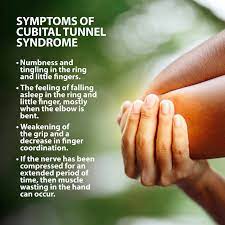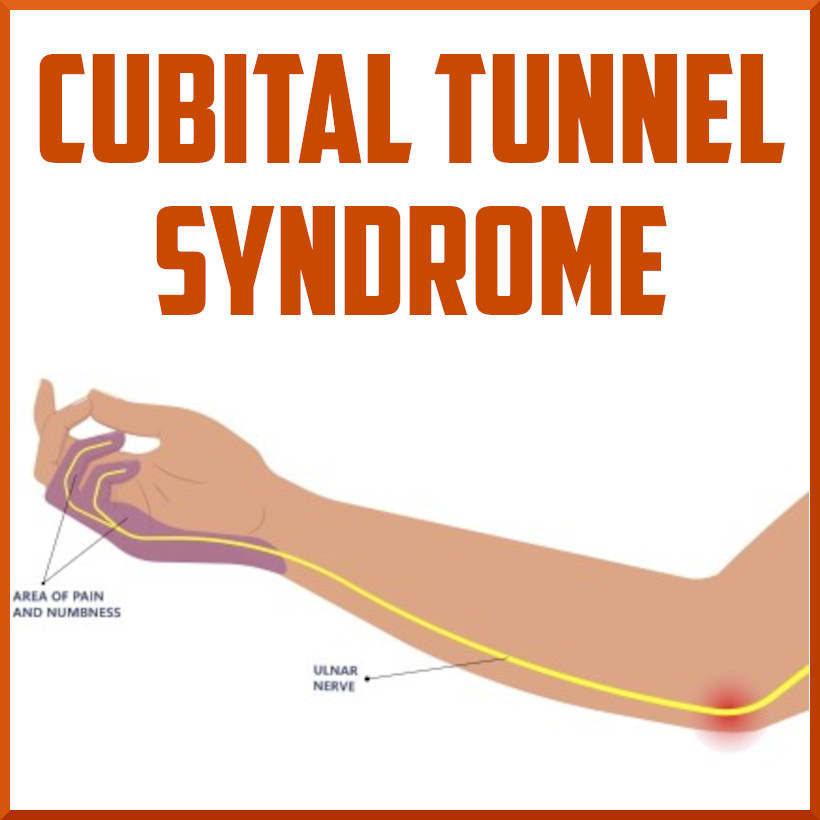Symptoms and treatment
Cubital tunnel syndrome is a condition that affects the ulnar nerve as it passes through a narrow tunnel of tissue in the elbow called the cubital tunnel. This condition is also known as ulnar nerve entrapment and can cause pain, numbness, and weakness in the hand and forearm.
Symptoms of Cubital Tunnel Syndrome:
The symptoms of cubital tunnel syndrome can vary depending on the severity of the condition. However, the most common symptoms of cubital tunnel syndrome include:
- Numbness and tingling: The most common symptom of cubital tunnel syndrome is numbness and tingling in the hand and fingers, especially in the ring and little fingers. This sensation is often described as a “pins and needles” feeling.
- Weakness: As the condition progresses, it can lead to weakness in the hand and fingers. This can make it difficult to perform everyday tasks such as gripping objects or holding a pencil.
- Pain: Cubital tunnel syndrome can also cause pain in the elbow, forearm, and hand. The pain may be sharp or dull and can worsen when the elbow is bent for an extended period.
- Difficulty with fine motor skills: In some cases, cubital tunnel syndrome can make it difficult to perform fine motor skills such as buttoning a shirt or tying shoelaces.
Treatment of Cubital Tunnel Syndrome:
The treatment for cubital tunnel syndrome depends on the severity of the condition. In mild cases, conservative treatment may be recommended, including:
- Rest: Resting the affected arm and avoiding activities that aggravate the symptoms can help alleviate pain and discomfort.
- Immobilization: Wearing a splint or brace can help keep the elbow in a neutral position and prevent further damage to the ulnar nerve.
- Physical therapy: Physical therapy can help improve strength and flexibility in the affected arm and reduce symptoms.
- Medications: Over-the-counter pain relievers and anti-inflammatory medications may help reduce pain and inflammation.
prevention of Cubital Tunnel Syndrome more severe cases, surgery may be necessary to relieve pressure on the ulnar nerve. The most common surgical procedure for cubital tunnel syndrome is called ulnar nerve transposition. During this procedure, the ulnar nerve is moved to a new location where it is less likely to be compressed. In some cases, the surgeon may also remove bone or tissue to create more space in the cubital tunnel.
Cubital tunnel syndrome can be prevented by following a few simple guidelines, including:
- Avoiding activities that put excessive pressure on the elbow: Activities such as leaning on the elbow for long periods or holding the elbow in a bent position for extended periods can increase the risk of developing cubital tunnel syndrome.
- Maintaining good posture: Maintaining good posture while sitting or standing can help reduce pressure on the ulnar nerve.
- Taking frequent breaks: Taking frequent breaks from activities that require repetitive motions can help reduce the risk of developing cubital tunnel syndrome.
Cubital tunnel syndrome is a condition that can cause pain, numbness, and weakness in the hand and forearm. The condition can be managed with conservative treatment or surgery, depending on the severity of the symptoms. Prevention of cubital tunnel syndrome is possible by avoiding activities that put excessive pressure on the elbow, maintaining good posture, and taking frequent breaks from activities that require repetitive motions.


